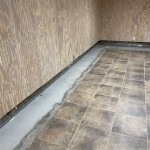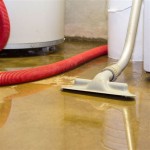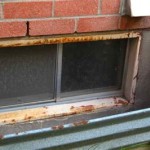What To Do With Standing Water In Basement: A Comprehensive Guide
Discovering standing water in a basement can be a homeowner's worst nightmare. The immediate reaction might be panic, but a calm and systematic approach is crucial to mitigate damage and prevent future occurrences. This article provides a comprehensive guide on how to handle standing water in a basement, outlining the necessary steps to take, potential causes to investigate, and preventative measures to implement.
The presence of standing water in a basement is not just an inconvenience; it presents several risks. Water damage can compromise the structural integrity of the building, leading to costly repairs. Additionally, stagnant water encourages mold growth, which poses a significant health hazard. Furthermore, electrical systems submerged in water can create dangerous shock risks. Therefore, addressing the issue promptly and effectively is paramount.
Immediate Safety Precautions
Before taking any action, ensuring personal safety must be the priority. Water in a basement, especially after heavy rainfall or a storm, may be electrically charged. Following these precautions minimizes risk:
1. Power Disconnection: The first step is to disconnect the power supply to the basement. This may involve switching off the main circuit breaker for the basement or the entire house if the source of the problem is extensive flooding. Using dry hands and wearing rubber gloves are imperative to avoid electrical shock.
2. Avoid Direct Contact: It is vital to avoid wading through the water if there’s a possibility of electrical hazards. If there's any equipment submerged in the water, refrain from touching it until the power is turned off.
3. Protective Gear: Wearing protective gear, such as rubber boots, waterproof gloves, and safety glasses, is essential during the cleanup process. These items will shield from potential contaminants and physical hazards in the water.
4. Ventilation: If possible, ventilating the basement by opening windows and doors can help reduce humidity and dissipate any potential mold spores or unpleasant odors.
Removing the Standing Water
Once safety precautions are in place, the next step is to remove the water from the basement. The method used will depend on the amount of water present and the available resources.
1. Sump Pump: If the basement has a sump pump, check its functionality first. Ensure the pump is plugged in and the discharge pipe is not blocked. Debris can often clog the pump's intake, preventing it from working correctly. If the sump pump is not working, consider replacing or repairing it immediately. A backup sump pump can be an invaluable asset during power outages or pump failures.
2. Wet/Dry Vacuum: For smaller amounts of water, a wet/dry vacuum can be effective. These vacuums are specifically designed to handle water and can be used to remove standing water from floors and other surfaces. Be sure to empty the vacuum frequently to prevent it from overflowing.
3. Submersible Pump: For larger volumes of water, a submersible pump is a more efficient option. These pumps are designed to be placed directly in the water and can pump it out through a hose to a designated drainage area. Ensure the pump is placed on a stable surface to prevent it from tipping over and that the discharge hose is properly positioned to avoid backflow.
4. Buckets and Mops: In situations where pumps and vacuums are not readily available, buckets and mops can be used as a temporary solution. This method is labor-intensive and time-consuming but can help reduce the amount of water in the basement until more efficient equipment can be obtained.
5. Professional Water Extraction: For extensive flooding, consider hiring a professional water extraction service. These professionals have specialized equipment and expertise to remove water quickly and efficiently, minimizing potential damage to the property. They can also assist with mold remediation and structural drying.
Identifying the Source of the Water
Removing the water is only the first step. Identifying and addressing the source of the water is crucial to prevent future flooding. Several potential causes should be investigated:
1. Foundation Cracks: Inspect the foundation walls for cracks, both inside and outside the basement. Even small cracks can allow water to seep into the basement. Seal any cracks with a waterproof sealant or consult a professional for structural repairs.
2. Poor Grading: Evaluate the grading around the foundation. The ground should slope away from the house to direct water away from the foundation. If the grading is sloped towards the house, water can pool around the foundation and seep into the basement. Regrading the landscape may be necessary to correct this issue.
3. Clogged Gutters and Downspouts: Check the gutters and downspouts for clogs. Debris, such as leaves and twigs, can block the flow of water, causing it to overflow and accumulate around the foundation. Clean the gutters and downspouts regularly, and ensure downspouts extend far enough away from the foundation to direct water away from the house.
4. Leaking Pipes: Inspect all visible pipes in the basement for leaks. Look for signs of corrosion or dampness around pipe joints and connections. Repair any leaks promptly to prevent further water damage. Consider replacing old or corroded pipes to minimize the risk of future leaks.
5. Sewer Backup: If the water in the basement has a foul odor, it could be a sign of a sewer backup. This can be caused by a clogged sewer line or a problem with the municipal sewer system. Contact a plumber immediately to address the issue and prevent further contamination.
6. Window Wells: If the basement has window wells, ensure they are properly drained and covered. Window wells can collect rainwater and snowmelt, which can then seep into the basement through the windows. Install clear plastic covers over the window wells to prevent water from entering.
Drying and Dehumidifying the Basement
After removing the standing water and addressing the source, the next step is to dry and dehumidify the basement. This is essential to prevent mold growth and further water damage.
1. Air Circulation: Promote air circulation by opening windows and using fans. This will help to evaporate moisture and reduce humidity levels in the basement. Position fans to direct airflow across wet surfaces to speed up the drying process.
2. Dehumidifiers: Use dehumidifiers to remove moisture from the air. Place dehumidifiers in the basement and run them continuously until the humidity levels return to normal. Monitor the humidity levels with a hygrometer to ensure they are within the recommended range (30-50%).
3. Professional Drying Services: For extensive water damage, consider hiring a professional drying service. These professionals have specialized equipment, such as industrial-strength dehumidifiers and air movers, to dry the basement quickly and efficiently. They can also use moisture meters to detect hidden moisture in walls and floors.
4. Remove Wet Materials: Remove any wet materials, such as carpets, rugs, and furniture, from the basement. These materials can harbor moisture and promote mold growth. If the materials are salvageable, clean and dry them thoroughly before returning them to the basement. Otherwise, dispose of them properly to prevent further contamination.
5. Cleaning and Disinfecting: Clean and disinfect all surfaces that came into contact with the water. Use a mold-killing cleaner to kill any mold spores and prevent future growth. Pay particular attention to porous materials, such as drywall and wood, which are more susceptible to mold growth.
Preventative Measures
Preventing future occurrences of standing water in the basement is key to maintaining a dry and healthy home. Implementing the following preventative measures can significantly reduce the risk of water damage:
1. Regular Inspections: Conduct regular inspections of the basement, foundation, gutters, and downspouts. Look for signs of water damage, cracks, clogs, and leaks. Address any issues promptly to prevent them from escalating into larger problems.
2. Sump Pump Maintenance: Maintain the sump pump regularly. Test it periodically to ensure it is working correctly. Clean the pump and basin to remove any debris that could clog the pump. Consider installing a backup sump pump for added protection.
3. Proper Grading: Ensure the grading around the foundation is properly sloped away from the house. This will help to direct water away from the foundation and prevent it from seeping into the basement. Regrade the landscape if necessary to correct any drainage issues.
4. Gutter Cleaning: Clean the gutters and downspouts regularly to remove debris and prevent clogs. This will ensure that water flows freely away from the foundation. Install gutter guards to prevent debris from accumulating in the gutters.
5. Foundation Sealing: Seal the foundation walls with a waterproof sealant to prevent water from seeping through cracks. This will provide an extra layer of protection against water damage. Consider hiring a professional to apply the sealant for optimal results.
6. Interior Waterproofing: Consider interior waterproofing measures, such as installing a drainage system along the perimeter of the basement and applying a waterproof coating to the walls. These measures can help to redirect water away from the basement and keep it dry.
7. French Drains: Install a French drain around the perimeter of the foundation to collect and redirect groundwater away from the house. This can be an effective way to prevent hydrostatic pressure from building up against the foundation walls.
Dealing with standing water in a basement requires a multi-faceted approach, encompassing safety, water removal, source identification, drying, and preventative measures. By understanding the potential causes and implementing appropriate strategies, homeowners can effectively manage water damage and safeguard their property from future issues.

Basement Flooding Or Standing Water Problem Sign

How To Fix A Wet Basement Family Waterproofing

What To Do When Dealing With Standing Water Everdry Waterproofing

All Dry Of The Carolinas Basement Waterproofing Photo Album Standing Water In Unfinished

Crawl Space Water Damage Get Expert Solutions Helitech

How To Remove Standing Water In Your Basement

Carolina Basement Systems Waterproofing Photo Album With Standing Water In Greensboro Nc

How The Damp Soil Around Your Home Impacts Water Instrusion News And Events For Ayers Basement Systems

Drat It Not The Best Way To Go About Cleaning Out Basement

How Long Does Basement Waterproofing Last Acculevel Foundation Repair
Related Posts







